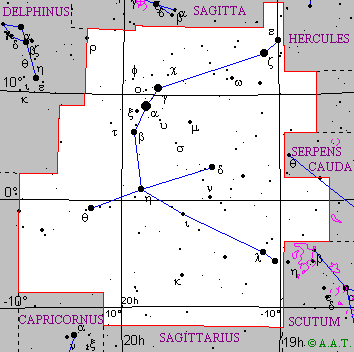 |
 |
| English name | Eagle | ||||
|---|---|---|---|---|---|
| Major stars | alpha Aquilae | Altair | magn. 0,8 | RA: 19h 50m 46.92s | Dec: +08° 52' 05.2" |
| gamma Aquilae | Tarazed | magn. 2,8 | RA: 19h 46m 15.59s | Dec: +10° 36' 47.9" | |
| delta Aquilae | magn. 3,4 | RA: 19h 25m 29.86s | Dec: +03° 06' 53.0" | ||
| zeta Aquilae | magn. 3,0 | RA: 19h 05m 24.61s | Dec: +13° 51' 48.6" | ||
| theta Aquilae | magn. 3,4 | RA: 20h 11m 18.28s | Dec: -00° 49' 17.3" | ||
| lambda Aquilae | magn. 3,5 | RA: 19h 06m 14.94s | Dec: -04° 52' 56.8" | ||
| Description | The constellation of Aquila, divided into halves by equator, is to the north of Sagittarius, surrounded by some minor constellations such as Sagitta, Delphinus and Scutum. In Aquila there is one of the brightest stars of the sky, Altair, which is 16 light-years away from the solar system and is therefore one of the nearest stars. With Deneb of Cygnus and Vega of Lyra, it forms the so-called Summer Triangle. An other important star of the constellation is eta Aquilae, one of the brightest variable cepheides: every 7,2 days it varies from the magnitude 4,1 to the magnitude 5,3. |
||||
| Mythology and history | About this constellation there are in particular two versions. The first one, told by Ovid, says that Zeus, fallen in love with the beautiful little boy Ganymede, changed in an eagle and abducted the stripling bringing him on the Olympus. Ganymede is represented in the near constellation of Aquarius. The second version, reported by Hyginus, associates the constellation of Aquila with that of Cygnus. Zeus was fallen in love with the goddess Nemesis, but she was not willing to accept him. Therefore Zeus changed into a swan and gave instructions to the goddess Aphrodite so that she pretended to pursue him having the shape of an eagle. Nemesis fell in the trap: pitied, she gave shelter to the escaping swan... and she found herself between Zeus' arms. To remember this loving trick, Zeus set the figures of swan and eagle among the stars. |
||||
 Back to constellations page.
Back to constellations page.